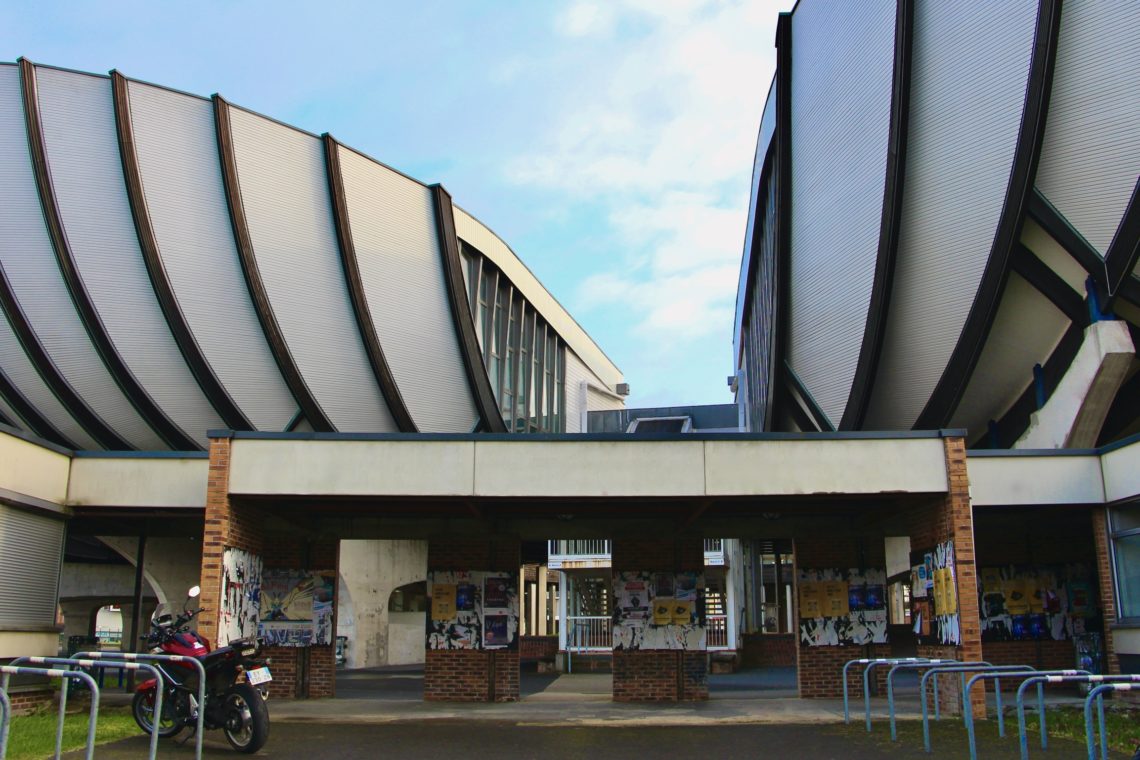
Four Interesting Ways Our French University Campus Surprised Us
Apart from the fundamentals, the college experience in France and the college experience in the United States have very little in common. We should know – after completing our American bachelor’s degrees at the University of Mary Washington, we moved abroad and are currently pursuing our master’s degrees in France at the Université de Reims Champagne-Ardenne. Some of the most jarring contrasts we’ve noticed as American students in Reims stem from the differences in our universities’ campuses.
In France, the right to education extends past high school. To give everyone the opportunity to pursue higher education, public universities in France cost next to nothing for students. For comparison, we pay 243 € per year in tuition at the Université de Reims Champagne-Ardenne whereas the average tuition for a public, in-state university in the USA comes to over $10,000. French public schools make do with fewer funds when compared to American public schools, which necessarily affects all aspects of French university culture. The glamorous, all-inclusive, resort-like character of colleges in the United States is totally out of the question.
However, we’ve found that the comparatively simpler way of life at our French university is more than just a reflection of limited resources. In many ways, French public schools attest to the country’s deeply held beliefs – from accessible education to the importance of striking a healthy work-life balance.
Though we can only accurately speak about our own schools, the conclusions we’ve drawn reveal larger cultural differences between France and the USA. Are American campuses better than French campuses? Keep reading to find out!
Campus Architecture
University campuses in America often feel like places of learning. Old-style brick buildings, collegiate columns, and beautiful archways make up just some of the iconic architecture that has come to be associated with attending college in the states. The scholarly aesthetic of American colleges is part and parcel of pursuing higher education there.
Though some French universities still hold class in historical buildings, many schools have shifted to a more modern style of architecture over the course of various renovations and additions. Colorful, boxy, industrial buildings house offices, classes, and libraries in universities all over France. This style of architecture is not unique to French schools, meaning that the campus feel is often completely absent.
In all likelihood, the difference in appearance between American and French campuses comes down to how much money the schools are able to pour into beautification. Though colleges in the United States are appealing to look at, what matters most is the quality of education that they provide. Given that French schools charge students so little in tuition, it makes sense that the appearance of their campuses aren’t the top priority.
The fact is that higher education is much more accessible in France than in the USA. We appreciate that ensuring that anyone can go to college is something that the French value highly – even if it means sacrificing a bit of beauty.
+1 point for France
American University Campuses – 0
French University Campuses – 1
Recreational Areas
Spaces for relaxation and entertainment are common features of college campuses in the United States. From manicured outdoor zones to designated leisure rooms, you don’t have to leave campus to unwind. It’s no surprise that American college students spend tons of time in these curated areas.
Not so in France! You won’t find students hanging out on luxurious couches in front of flat screen TVs on a French campus. A room with vending machines and a few tables is about as close as you’ll get to a chill spot at school.
This is an example of the fundamental disparity between the French and American conceptualizations of university. Americans expect an all-in-one package deal – meaning that campus should be the place where students work and play. Conversely, French students see their university solely as their workplace – meaning most wouldn’t dream of spending more time than necessary there.
Both outlooks have their pros and cons. While American campus amenities are impressive, students have weak boundaries between where they study and where they relax. Though French campuses may seem bare in comparison, students spend a healthy amount of time away from their school environment. We’ve found ways to thrive in both situations, but truthfully prefer the American one-stop-shop campus.
+1 point for the United States
American University Campuses – 1
French University Campuses – 1
Residence Halls
At Mary Washington, on-campus living is highly encouraged. When we were students there, a whopping 17 on-campus residence halls were available for students to live in. Jalen and I loved living on campus so much that we both worked for the Office of Residence Life and stayed in residence halls for the entirety of our undergraduate career.
Student residences do exist in France. Even so, they aren’t affiliated with any school, they aren’t always located on campus grounds, and there aren’t enough rooms for every student to live there. These residences are operated by the French government and aim to house low-income students in modest dormitories near universities. For French students, a student residence is just a place to lay your head. For these reasons, many students in France choose to rent from private landlords rather than living in a student residence.
American colleges hire Residence Life professionals and student RAs to create a welcoming atmosphere, ensure residents’ safety, and enforce university policies. In France, such an environment would be seen as infantilizing and extravagant. The perks of on-campus living – like never being far away from your classes, reveling in a friendly community ambiance, and being surrounded by motivated students – played an important role in our success during our bachelor’s degrees in America. It’s also worth noting, however, that the privacy, independence, and freedom of living off campus has been crucial to us as master’s degree students in France.
It seems to us that the discrepancy comes down to how American and French societies view young adults. In the USA, undergraduate students are widely seen as beginning the transition into adulthood. Conversely, French students are treated like autonomous adults at 18 years old. It’s hard to say which country gets it right, and we think that the choice to live on or off campus ultimately comes down to the maturity and needs of each individual student. All things considered, we preferred our on-campus life at Mary Washington to our off-campus experience in Reims.
+1 point for the United States
American University Campuses – 2
French University Campuses – 1
Campus Bookstore
University bookstores are emblematic of American college culture. Students can buy every product imaginable emblazoned with their university’s logo, from cute sweatshirts, to travel mugs, to fun keychains, to stuffed animals. Useful items, like textbooks, computers, and office supplies, are also found in the bookstore. All of these items cost money, and some of them are required for classes at the university.
Bookstores are totally absent from French campuses. You won’t see the French rocking t-shirts bearing their college’s name and professors don’t direct their students to the bookstore to purchase textbooks. Would you believe that we haven’t had to buy a single textbook for the entirety of our master’s degrees? Paying for anything other than food on a college campus just isn’t the French way.
Public American colleges don’t receive as much funding from the government as French colleges do, so they have to find ways to make a profit to stay afloat. Selling apparel appeals to the American obsession with school pride, and offering the textbooks that students are required to buy for their classes is a no-brainer. Increasing school spirit while making money for the university may sound harmless, but when compared to their French counterparts, American universities feel extremely commercial and materialistic.
We can’t say that we don’t love school-themed apparel – we were born and raised in the United States, after all. It honestly felt normal to cough up hundreds of dollars each semester for textbooks and stylish gear. Nevertheless, it’s become clear to us after moving to France just how profit-oriented American colleges really are. We’ve come to favor the way things are done in France, where walking onto campus doesn’t feel like a trip to the mall.
+1 point for France
American University Campuses – 2
French University Campuses – 2
It’s a tie! American campuses and French campuses have unique advantages and disadvantages that are both informed by each country’s cultural norms. Neither nation does higher education perfectly, but Jalen and I feel lucky to have had the opportunity to attend university in both places. Did any of these differences surprise you? Let us know in a comment!
Take a tour of the Université de Reims-Champagne Ardenne’s campus in this video!
To learn more about how French and American universities differ, watch our video.
You May Also Like

Studying in France as Americans: Our Master’s Degree Journey is Complete
October 26, 2022
Useful Blog Posts for International Students in France
November 9, 2022

